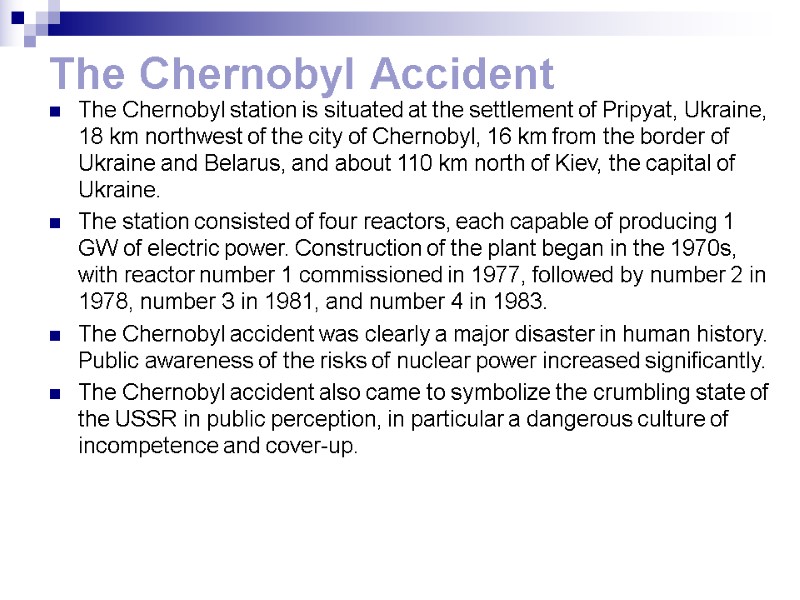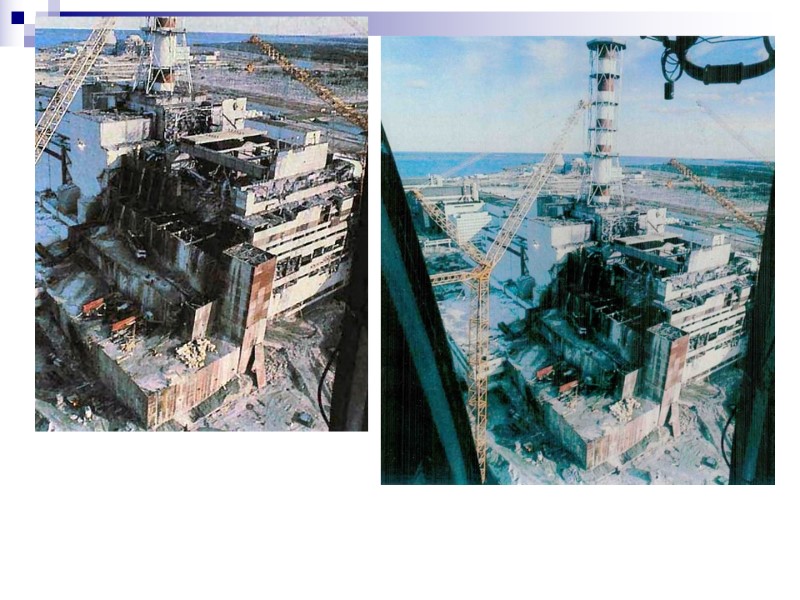The Chernobyl Catastrophe The Chernobyl Accident The Chernobyl


The Chernobyl Catastrophe

The Chernobyl Accident The Chernobyl station is situated at the settlement of Pripyat, Ukraine, 18 km northwest of the city of Chernobyl, 16 km from the border of Ukraine and Belarus, and about 110 km north of Kiev, the capital of Ukraine. The station consisted of four reactors, each capable of producing 1 GW of electric power. Construction of the plant began in the 1970s, with reactor number 1 commissioned in 1977, followed by number 2 in 1978, number З in 1981, and number 4 in 1983. The Chernobyl accident was clearly a major disaster in human history. Public awareness of the risks of nuclear power increased significantly. The Chernobyl accident also came to symbolize the crumbling state of the USSR in public perception, in particular a dangerous culture of incompetence and cover-up.

On Saturday, April 26, 1986, at 1:23:58 a.m. local time, the fourth reactor of the Chernobyl power plant known as Chernobyl-4 suffered a catastrophic steam explosion that resulted in a fire, a series of additional explosions, and a nuclear meltdown. It is regarded as the worst nuclear accident in the history of nuclear power ever happened. It produced a plume of radioactive debris that drifted over parts of the western Soviet Union, Eastern Europe, Scandinavia, UK, and even eastern USA. Large areas of Ukraine, Belarus, and Russia were badly contaminated, resulting in the evacuation and resettlement of more than 300,000 people. About 60% of the radioactive fallout landed in the neighbour republic Belarus. Even now it is difficult to accurately tally the number of deaths caused by the event at Chernobyl, as most of the expected deaths are from cancer, have not yet actually occurred, and are difficult to attribute specifically to the accident.


Residual radioactivity in the environment The Chernobyl nuclear power plant is located next to the Pripyat River, which feeds into the Dnipro River reservoir system, one of the largest surface water systems in Europe. The radioactive contamination of aquatic systems therefore became a major problem in the immediate aftermath of the accident In the most affected areas of Ukraine, levels of radioactivity in drinking water caused concern during the weeks and months after the accident. After this initial period, however, radioactivity in rivers and reservoirs was generally below guideline limits for safe drinking water Bio-accumulation of radioactivity in fish resulted in concentrations (both in western Europe and in the former Soviet Union) that in many cases were significantly above guideline maximum levels for consumption In small "closed" lakes in Belarus and the Bryansk region of Russia, concentrations in a number of fish species varied from 100 to 60,000 Bq/kg during the period 1990–92. The contamination of fish caused short-term concern in parts of the UK and Germany and in the long term (years rather than months) in the affected areas of Ukraine, Belarus, and Russia as well as in parts of Scandinavia.

Flora and fauna After the disaster, four square kilometers of pine forest directly downwind of the reactor turned reddish-brown and died, earning the name of the "Red Forest" Some animals in the worst-hit areas also died or stopped reproducing. Most domestic animals were removed from the exclusion zone, but horses left on an island in the Pripyat River 6 km from the power plant died when their thyroid glands were destroyed by radiation doses of 150–200 Sv. Some cattle on the same island died and those that survived were stunted because of thyroid damage. Of the 440,350 wild boar killed in the 2010 hunting season in Germany, over 1,000 were found to be contaminated with levels of radiation above the permitted limit of 600 bequerels, due to residual radioactivity from Chernobyl. The after-effects of Chernobyl were expected to be seen for a further 100 years, although the severity of the effects would decline over that period

Groundwater was not badly affected by the Chernobyl accident since radionuclides with short half-lives decayed away long before they could affect groundwater supplies, and longer-lived radionuclides such as radiocaesium and radiostrontium were adsorbed to surface soils before they could transfer to groundwater It is unknown whether fallout contamination will have any long-term adverse effect on the flora and fauna of the region, as plants and animals have significantly different and varying radiologic tolerance compared with humans. Some birds are reported with stunted tail feathers (which interferes with breeding). There are reports of mutations in plants in the area.





12012-the_chernobyl_catastrophe.ppt
- Количество слайдов: 12

